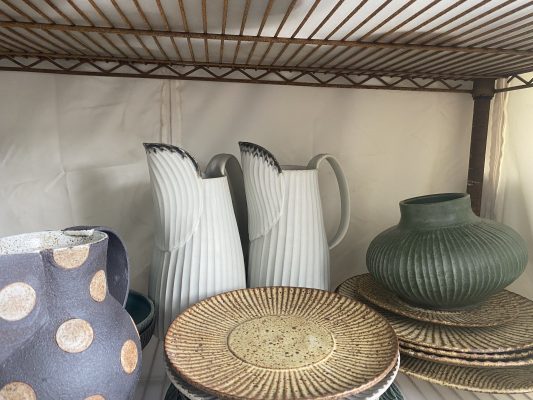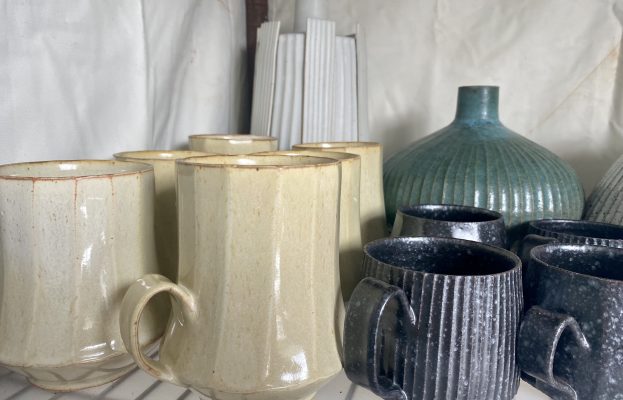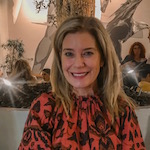Zoe Dering is a former pastry chef who took five years off and emerged on the other side as a celebrated ceramic artist. Based in the rural western part of the county, Dering is part of Marin’s current and long tradition of ceramic creators — from the home goods pioneer Edith Heath (Currently featured in the Oakland Museum of California exhibition Edith Heath: A Life in Clay) and sculptor JB Blunk (on view at Blunk Space in Pt. Reyes Station) to current working artists exhibiting at a host of venues including MarinMOCA, Marin Open Studios, ICB Building, Terra Linda Ceramic Artists, and more.
This weekend, Dering will be featured at Blunk Space as a popup exhibition, which will include functional wares, sculptural vases, pendants, and table lamps.
Below is an interview with UPTAKE contributor Jennifer Wechsler.
* * * * *
Jennifer Wechsler: How did you get started in this particular medium?
Zoe Dering: It was 2010-2011; I worked as a pastry chef in San Francisco, which I’d been doing for maybe seven years. “Younger me” had always been interested in the arts and thought about going to art school, but I didn’t. I went to pastry school instead, then immediately dove into that career. Before that, I apprenticed with a painter in Mexico and took art classes. Then, pastry took all my social and creative time as I went a little tunnel-visioned into it, which is not a bad thing. I enjoyed myself.
But there was a point where I started to wake up wanting something a little more or different. I started taking night ceramics classes, and I got obsessed with it.
Jennifer: That obsession happens, especially when you’re good at something.
Zoe: I wasn’t good, to begin with, but I had enough of an aptitude that I wanted to keep going with it. All of its processes clicked with me in a way that, despite my skill level still being low, I just really wanted to keep doing it. I like process-oriented things. I like long, hard processes.
I was doing night classes, getting really into it, spending all my extra time at the studio that I could, and friends supported me. I made some mugs, which in retrospect, I think, “My God, they were so bad,” but people loved them. It was very sweet. I lived in the Outer Sunset and made a line of mugs for Trouble Coffee. So just little things here and there gave me confidence in it. And then I remember my boss at the time joking that he wished that I liked baking as much as I enjoy pottery, and he wasn’t wrong.
I hit a point. I was working at a restaurant, I reached the end of the line there, and there was nowhere else I wanted to go. It was not a smooth transition. I quit the job and moved out of the city. Sort of unintentionally, I gave up my apartment to see what would happen. I floated around. I visited family in Mexico, people on the East Coast, and then up in the mountains for about a year before eventually landing in Oakland and joining a pottery studio again. It still was mostly a hobby but gained some momentum. I was 30 maybe, and I got fired from a coffee shop. I thought, “I wasn’t valuable enough for a coffee shop? Maybe I shouldn’t be doing this anymore.”
I used that as a segue. I worked for a friend who’s a private chef intermittently to make ends meet and just focused all my attention that way, and then it slowly grew over time. In 2017, my partner and I moved out here to Inverness. I had my studio home for the first time. I could focus, and it took off from there. As you know, in Inverness, it can be a fairly isolated or insular lifestyle. You sink into the zone a little bit.
Jennifer: Can you describe your experience creating functional or decorative objects by hand using various methods and materials. Or your procedure, your practice.
(See glossary of ceramics terms)
Zoe: There’s so much process to clay, and you can’t skip much of it. You start with taking the raw clay that comes in a bag and kind of a block form, and you cut it and weigh it into whatever weight you want. And then you wedge it, which is this process of preparing the clay to be used on the wheel where you form it into a spiral, and then put it on the wheel.
And then there are many steps to throwing something, depending on the form.
My work is highly textured, which comes later. The piece has to dry a bit before you can trim it, which is just the process of cleaning up the bottom, maybe putting a foot on it if the form wants it. The leather-hard state is between the wet and dry phase of the clay in the drying process when clay feels like leather. You can sink a fingernail into it, but the pot won’t collapse at its first touch.
Using fluting tools, I then carve away portions of the surface of the clay to create texture. And then the clay dries longer until it’s what’s called bone dry, which is when all of the water that can evaporate at room temperature from the clay, and then you bisque fire it.
Biscuit firing is at about 1800 degrees, considered a low fire. At that point, once it comes out of that firing, it’s ready for glaze. Then, I do all of my glaze firing in a Cone 10 reduction kiln that I use in the East Bay.
I did have another potter ask me recently, “how did you get so good?” And I was embarrassed by the question, but it was just practice. You have to practice.
Zoe Dering
Jennifer: I always think of you with texture and how important that is in your practice. Is that something that you knew from the beginning you wanted to achieve?
Zoe: I was throwing forms and glazing them in the beginning. There’s plenty that can be done in that regard using the combination of glazes, how you fire them. That’s a whole world in and of itself, and that’s completely fascinating. When I was working in the East Bay, I was a Berkeley Potters’ Studio member. I don’t know how I got into carving things. I think at some point, I was doing more sgraffito work, which is adding like a layer of colored slip, which is like a liquid clay to the surface of things and carving through it, and somehow that evolved into more textual work.
My patterns now are very organized. They used to be a little more organic. And then slowly over time, I think partially through evolution and partially through just function, things got a little more organized. It’s a little easier for me. And also, when you’re in production mode, it’s just anything you can do to make it easier on your body physically is a gift.
Jennifer: But was texture the destination?
Zoe: No, I don’t have a direct conversation with my inspiration, and I prefer to keep it that way.
With ceramics, I think this is true of many other craft and art forms as well; you’re limited by form, especially making functional pieces. So many people are making bowls. So many people are carving their pieces. There are forms, techniques, and a finite number of them. But there are not that many people out there revolutionizing these things. So you are up against how to find your voice while using exactly the same things as everybody else.
And one thing I’ve noticed, especially in the internet age, is: that happens, I’ve done it, everyone’s done it. It’s that you accidentally end up emulating somebody’s work that you’ve admired or something that you’ve seen. And I think that’s okay. You can’t distance yourself from your inspiration or your influences, but what happens a lot is that people produce the same work. For the most part, I think most people are not intentional. I think it’s just a byproduct of where people are in their careers and what they’re paying attention to at that time.
And then with ceramicists, there’s another layer of it because it’s often houseware. You can pay attention to what’s trendy, which is not my concern, but it is a thing that happens a lot: What’s sellable? I’ve been intentional about not watching other people’s work too closely except those who I think are really just doing something totally different than I’m doing. I admire it aesthetically or otherwise, but I try to keep a pretty serious distance from that kind of observation. Then you’re just left with the dark, scary part of being an artist where you have to think about what you want your work to be. And I don’t even know how to put that part into words.
Jennifer: Tell us about the business aspect of your work.
Zoe: The business aspect is tricky because it’s not how I identify first and foremost. The selling part started with wholesale accounts, which was wonderful, and a great way to get my name out there and work with really great people. Over the years, I grew less interested. It’s hard to take 50% of the cost of an item and make a living that way when something is so physical. Now, I’m a little more willing to charge more for my work. But, at the end of the day, it’s still just 50%, which can be tough.
I think stores, not all but many places, want to carry more accessible price points. So if a mug is $50 or $60, you’re still only making $25 or $30, and that gets tricky.
I was feeling really, really claustrophobic with the producing lines of certain styles over and over. And then with that growth, things become popular, which is wonderful, but then you get a little bit trapped by making it. This happens a lot with other potters in my community because everyone’s kind of – not everyone – some people do really set out just to set a business and make this one thing and put it out there, and that’s great. I can’t do it for some reason. Part of me wishes I could. The minute somebody’s like, can I get a hundred of the style of a mug? I’m like, I never want to make it again.
It does for some reason, and it’s a bummer, but it’s just a tricky space for me to navigate. So I’ve been trying to kind of craft more of a one-of-a-kind model. The pandemic helped me understand that I can sell directly. Growing in a way that’s creates something a little more sustainable, passively. For the first time, I got a plate produced offsite to order them and glaze them myself.

Jennifer: And you feel okay with having someone else produce a piece?
Zoe: It took me forever to come to that decision. I was getting so many requests for this one style. It was a hefty investment but not an impossible one, and it, in theory, should work out in the end. I need to design a box for them. I need to have a plan for them. Thankfully I have a friend who is helping me with that.
I make handmade one-of-a-kind things, and here I am making a slip casted and ram pressed, and it’s mass produced. And some people will react to that; most people don’t seem to care. I made the master mold, glazed it, and fired it. I’ll be able to offer something like that to wholesale clients. It’s prototyping right now, launching it in April, and, with any luck, it will go well, and then I can kind of leapfrog that into offerings like a bowl or a mug in that style.
Jennifer: You’re an entrepreneur. You only have so much energy and time. You’re one person here. Having someone produce is going to help you thrive and stay present. And you’re still doing one-of-a-kind, collectible pieces possibly for museum shows?
Zoe: Mariah (Blunk) just asked me: “Are you a potter, a ceramicist, an artist?” And I said I don’t know. We settled on ceramic artist. But there are days that I just feel like a potter. I don’t even know if I know the difference, if I’m being honest. I settled on ceramic artist because of that one-of-a-kind work.
I don’t think it even matters what I call myself, but it’d be nice to have not closed myself off from the art world by identifying too heavily in craft. There were times when I have put a vase in a show, and it felt weird to me, but that might be me more than anything. Because I think with craft, people perceive it (the work) in different ways, and people tend to have opinions about it, whether or not they’ve thought about it.
I’m excited with the sculptural vessels because they do feel like they’re starting to blur some lines there and cross over into different spaces.
Jennifer: What other aspirations would you like to do with your practice and your career? Where would you like to see yourself in 10 years?
Zoe: I’m never good at that question. Who even knows at this point? Since I’m a little over the hump of an existential crisis with my practice, I feel there is a certain satisfaction with where I’m at now. Allowing a helper in the studio, which is not easy because I’m not super regimented, would be good. But it’s my practice, and I’m a control freak about it.
Jennifer: That’s good, though; it shows. What percentage is custom work, would you say?
Zoe: It’s a fair amount at this point. I don’t even know, maybe, 70%. That’s the quiet stuff behind the scenes, and then I seek out personal work. I’ve pushed to get a body of work made specifically for a selling event. While that’s not custom, it will probably end up being a fairly significant portion of things in the end. Then, when I do West Coast Craft twice a year, that’s a huge push also. I’ll be focusing on a bunch of custom stuff and throwing in personal work here and there. Then, I’ll pause and do a whole bunch of personal work.”

Jennifer: Do you feel the craft fairs have helped you generate a following?
Zoe: I think so. The internet has been helpful, and people have come to associate me with Bay Area pottery, which is cool.
Jennifer: You’re so good. You work hard.
Zoe: It is definitely hard work. I did have another potter ask me recently, “how did you get so good?” And I was embarrassed by the question, but it was just practice. You have to practice. But everyone has a different setup in life. When I started my practice full-time, my rent was $500. I was living in Oakland; I had below-market rent. That was the only way it worked. Do you know what I mean? Everyone has different situations, and some people might not be able to leap sooner. Other people might not be as reckless as I am.
Jennifer: Well, it takes a particular person to be able to push through and to their aspirations and their dreams, to make it into reality. You are one of them.
Zoe: Thank you.
Jennifer: And I’m so happy to know you.
Zoe: I’m so happy to know you.

Jennifer Wechsler serves on boards at UCLA ARTS and the Marin MOCA Museum. She also is a curator for FAULTline Art Shows exhibiting emerging and established artists in unique spaces and owner of TessutoEditions.